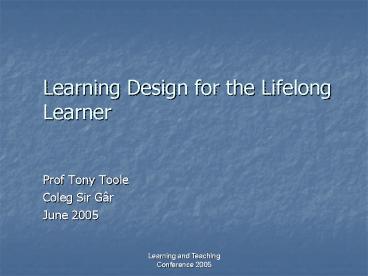Learning Design for the Lifelong Learner - PowerPoint PPT Presentation
1 / 20
Title:
Learning Design for the Lifelong Learner
Description:
Coleg Sir G r. June 2005. Learning and Teaching Conference 2005. Agenda ... The Characteristics of the Lifelong Learner. Learning Design for the Lifelong Learner ... – PowerPoint PPT presentation
Number of Views:379
Avg rating:3.0/5.0
Title: Learning Design for the Lifelong Learner
1
Learning Design for the Lifelong Learner
- Prof Tony Toole
- Coleg Sir Gâr
- June 2005
2
Agenda
- Background the Wales e-Training Network
- The Characteristics of the Lifelong Learner
- Learning Design for the Lifelong Learner
- Case Study Web Site Design
- Designing Out the Constraints of Technology
3
e-Training Networks
- SW Wales
- SE Wales
- N Wales
- Collaboration
- Shared development of materials
- Focussed on needs of SMEs
- Capacity building programme
- Concept proving objective
- Interoperability access
4
The Rationale for the e-Training Network Why we
are doing it
5
The On-line Lifelong Learner
- Average age 38yrs, normal distribution
- Typically employed, housebound or otherwise
constrained - Range of reasons for engaging with learning
- Range of experience and expertise
- Range of learning styles and preferences
6
The Consequences of Diversity
- A one size fits all learning design model does
not work - Differing time constraints means learners all
study at different times of the day and week, and
follow different study patterns - Subject knowledge and, particularly, practical
experience, mean learners are looking for
different outcomes and benefits - Different support needs relating to ICT, study
support disabilities
7
Lessons we have learned .
- We need to provide multiple routes through the
materials and allow students to make their own
choices - We need to communicate proactively with the
students and provide structured formative
feedback on achievement - We need to allow the students to build on their
existing skills and knowledge and to undertake
learning activities that are relevant to their
interests and learning needs - We need to provide plenty of opportunities to
communicate for those who are most comfortable in
a community of learners, whilst allowing those
who wish to plough a lone furrow to do so
8
A New Learning Design Model
- Based on constructivist, situated learning
approach employing discovery learning activities
in communities of practice - Modular with clusters of credit rated learning
outcomes. Nested levels of learning support
resources - Student chooses own mix of learning outcomes to
attain, level of support required and where
when the learning will take place - Negotiated learning agreement with module tutor
9
Start Module discuss with tutor
Module Descriptor This will explain the learning
objectives of the module and the number of
activities to be carried out
Learning Activities Learning Activity 1.
Description, learning outcomes, student choices,
examples . Learning Activity N. Description,
learning outcomes, student choices, examples
Choose Learning Activity choose personal
application, agree with tutor
Level 1 Materials Bullet point explanations,
assumes knowledge of software, menu structures
and all basic functionality bullet point 1
explanation . bullet point N explanation
Y
Need Learning Materials?
N
N
Need Further Materials?
Complete Learning Activity discuss drafts with
tutor agree final version submit
Y
Level 2 Materials Further explanation of topic,
example, exercise)
N
Need Further Materials?
N
Learning Activities Complete?
Y
Y
Level 3 Materials Full topic coverage, examples,
exercises, tutorial)
End Module discuss with tutor
10
(No Transcript)
11
Case Study Web Site Design Module
- Based on a social-constructivist model of
learning design - Created by Alex Bell at Trinity College
Carmarthen - On-line resources primarily to advise and guide
learner through the learning process - Academic content acts as a gateway to the subject
refers to off-line resources - The learning process is 100 activity based
12
(No Transcript)
13
(No Transcript)
14
(No Transcript)
15
(No Transcript)
16
(No Transcript)
17
(No Transcript)
18
Learning Design Issues
- E-learning, like any learning, involves a process
of knowledge and skills acquisition - It is the process that is the key to good
learning design, not the resources - The value of e-learning is in the flexible access
it provides to communications, information
exchange and global resources
19
Designing Out the Constraints of Technology
- If file size and bandwidth are an issue, dont
deliver resources on-line - When you do deliver on-line, use the simplest
effective communications medium - Use multimedia and interaction when this is
demonstrably more effective at facilitating
learning - Effective use of synchronous and asynchronous
communications is currently constrained by
technology, but will ultimately be constrained by
the quality of learning design
20
Learning Design for the Lifelong Learner
- For more information contact
- tony.toole_at_virtualcollege.ac.uk































